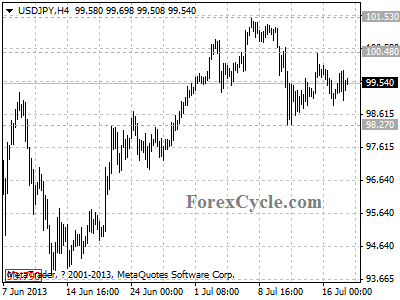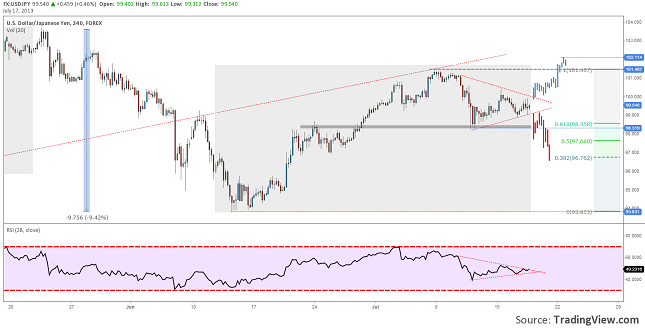By MoneyMorning.com.au
The price of oil is rising lately, due to ‘events in Egypt’, as the saying goes. Well, yes. Despite being home to modest oil output with zero net oil exports, Egypt owns the Suez Canal. Thus, disruptive events in Egypt can move oil prices, at least in the short term while oil operators reroute large tankers.
Indeed, here’s the recent oil price chart, showing a rise of $8 or so per barrel (via the Brent crude benchmark) in the past few weeks:
When you fit the oil price chart to recent news events, it’s not hard to determine that something happened somewhere. No doubt that, say, the Saudis are pleased that their daily oil exports now yield another $80 million to the royal family bank accounts with which to pay for princely perks.
The Egypt Oil Story
Of course, as you doubtlessly know, in mid-June, about 14 million angry Egyptians took to their local streets. Poor and hopeless beyond most outsiders’ ability to comprehend – and really, you’ve got to visit Egypt to see how badly off the people are! – the (literally) starving, jobless masses protested the year-old government run by elected ideologues of the Islamist Muslim Brotherhood.
In response to evident repudiation of a ‘democratically elected’ government (long story there…), the well-fed Egyptian military guys answered the call by removing the clerical fascists who were and are, by most metrics, utterly incompetent to govern. Judge not, lest ye be judged, I suppose.
So that’s the recent Egypt oil story, or so some people say. Rising oil prices are all about Egypt, or so some people say.
Long-Term Oil
Then again, let’s step back and look at how Egyptian events fit into the long-term oil picture. Here, for example, is the oil price chart since the year 2000:
As you can see, long-term trends in oil prices follow a path of their own. That short, tight price spike in 2001 was – you know this – the oil market’s response to the Islamist terror attack on the US on Sept. 11 of that year.
A few years later, the big oil price run-up in 2007 and 2008 was due to the global financial melt-up. The price crash of 2008 was due to…well, the Crash of 2008.
Oil prices recovered in 2009-2011. This was not due to any significant economic recovery in the West, to be sure. Neither North America nor Western Europe was the world’s ‘economic locomotive’, to use a term from the olden days of the 1980s.
No, rising oil prices in 2009-2011 were due to energy demand growth across global emerging markets – certainly China, but also India and a host of other smaller economies.
Indeed, Western oil demand has fallen in recent years across the US, Canadian and Western European economies. Meanwhile, fast-growing, emerging markets bid up the price for marginal barrels.
The oil price plateau of 2011 through now – that $95-115 range for the Brent Crude posting – was due to a combination of extreme economic distress in Japan (Fukushima meltdown) and Europe (eurozone meltdown) plus lingering recession in North America.
Now add in the evolving slowdown in China growth. (One acquaintance just got back from Beijing and stated categorically that ‘Everything big has stopped in China.‘ Uh-oh.)
Finally, of course, add in the oil supply increase from US and Canadian fracking. There’s your lack of significant oil price movement over the past two years, one way or the other.
Egypt’s Background Noise
So let’s get back to the first point I made in this note. Where do events in Egypt fit into this oil price picture?
Egyptian issues are important to people who are caught up in the day-to-day matter. It’s arguable that Egyptians – in both the street and the halls of the general staff – did what they had to do to remove a government that was on the verge of totalitarian rule while tipping the ancient nation into economic collapse, if not mass starvation.
(And note that post-takeover, the Russians and Chinese immediately offered food aid to Egypt, while the US promised four more F-16 fighter-bombers to the generals.) In the large picture, however, recent events in Egypt are background noise to long-term energy trends.
The Oil War Scenario
Of course, those same recent events in Egypt might presage a looming cultural clash across the Middle East, with wider impact on future energy prices. That’s another story, and it’s part of the ‘oil wars’ scenario that we’ve developed here over the past few years.
It’s not that Egyptian oil is so important to the world. Egypt’s oil – what the nation produces and what it imports – is not a big number to world markets. You can see how exports to the global market (green) have been declining for years, here:
But the short version of ‘oil wars’ is that religious-based turmoil anywhere in the Middle East has the potential to disrupt oil flows and drive prices in a big way.
When nations fall apart in the Middle East, oil volumes get disrupted almost by definition. The disrupted oil could be anything from a few hundred thousand barrels per day (as with the Libyan civil war of 2011) to 10 million and more barrels per day (imagine the Strait of Hormuz closing). It can be enough to move prices.
So Egypt’s politics could affect other nations in the region. Thus, my view is to stay away from investments that are too exposed to turmoil in the Middle East. Focus more on producers far from the Middle East, as well as the drillers and service companies that make the oil wells happen.
Byron King
Contributing Editor, Money Morning
Publisher’s Note: This article originally appeared here.
Join Money Morning on Google+
From the Archives…
Quantam Computers – Why It’s Time to Believe the Unbelievable
12-07-2013 – Sam Volkering
Red Alert: Why This Stock Market Rally is a Trap
11-07-2013 – Murray Dawes
Why Oil Could be the One Commodity to Defy the Doom…
10-07-2013 – Dr Alex Cowie
Gold Breaks A Record
9-07-2013 – Dr Alex Cowie
Time to Plan for the Year-End Stock Rally?
8-07-2013 – Kris Sayce








